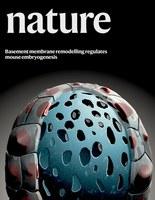
Submitted by Noelia Corral Ferre on Thu, 07/05/2020 - 11:25
New study by Zernicka-Goetz lab published on Nature on the mechanism of membrane perforation during the development of the mouse embryo
During development the mouse embryo implants in the mother’s uterus and undergoes a dramatic transformation. The resulting post-implantation embryo has an elongated morphology and is thus called an ‘egg cylinder’, surrounded by a physical extracellular matrix scaffold; the basement membrane. Remarkably, the egg cylinder enters a phase of exponential growth while maintaining its elongated morphology throughout, culminating in the initiation of gastrulation – a process that establishes the three germ layers: ectoderm, mesoderm and endoderm. This work reveals the physical role of the surrounding basement membrane in both morphology maintenance and gastrulation of the developing mouse embryo.
Our data shows that the laminin- and collagen-rich basement membrane keeps the morphology of the egg cylinder in place by promoting the embryo’s directional growth. It achieves this by allowing holes (perforations) to be made at the distal (embryonic) portion, thus making it more distensible to forces generated by growth. As the embryo grows and moves towards gastrulation, the perforations on the basement membrane redistribute and accumulate in the posterior in response to anterior-posterior axis establishment. This newly established posterior perforation domain lays down the ground for progressive breaching of the basement membrane during gastrulation, according to the ‘run in the stocking’ model. This model proposes that localized remodelling of the basement membrane leads to its weakening at a specific domain, which will open and expand in response to forces induced by growth (Moore et al., 2005).
The ability of the basement membrane to become perforated to accommodate tissue growth and shaping has been suggested before in bud expansion and branching. However, notable to this study is the dynamicity of this process in response to developmental events and its immediate repurposing to orchestrate embryogenesis. The mechanism of perforation formation and regulation proposed in this study is likely to have implications beyond development and stem cell fields of research, especially in cancer and metastasis.
Moore, K. A., Polte, T., Huang, S., Shi, B., Alsberg, E., Sunday, M. E., & Ingber, D. E. (2005). Control of basement membrane remodeling and epithelial branching morphogenesis in embryonic lung by Rho and cytoskeletal tension. Developmental Dynamics, 232(2), 268–281.
https://www.nature.com/articles/s41586-020-2264-2

